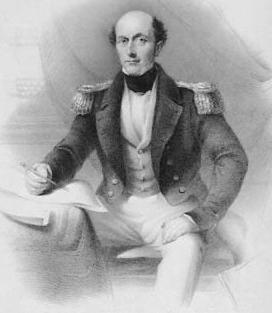William Symonds facts for kids
Quick facts for kids
Sir William Symonds
|
|
|---|---|

Sir William Symonds, by Edward Morton,
1850 (after Henry Wyndham Phillips) |
|
| Born | 24 September 1782 Bury St Edmunds, Suffolk |
| Died | 30 March 1856 (aged 73) Aboard the French steamship Nil in the Strait of Bonifacio, off Sardinia |
| Allegiance | United Kingdom |
| Service/ |
Royal Navy |
| Years of service | 1794–1856 |
| Rank | Rear admiral (rank granted on retirement) |
| Battles/wars | Groix |
| Awards | FRS, knighthood, civil Companion of the Bath |
| Relations | Thomas Symonds (father) Mary Anne Whitby (sister) William Cornwallis Symonds (son) Thomas Symonds (son) Julian Symonds (son) Jermyn Symonds (son) |
| Other work | Surveyor of the Navy |
Sir William Symonds (born September 24, 1782 – died March 30, 1856) was an important officer in the Royal Navy. He served as the Surveyor of the Navy from 1832 to 1847. In this role, he helped make big changes to how naval ships were designed and built.
Contents
Life and Career
Early Years at Sea
William Symonds was born in Bury St Edmunds, England. He was the second son of a naval captain, Thomas Symonds. William started his own naval career very young, joining the ship HMS London in September 1794.
He was part of Lord Bridport's fleet at the Battle of Groix in 1795. He also saw the Spithead mutiny in 1797. He became a lieutenant in 1801. During the Napoleonic Wars, he noticed that French ships were often faster than British ones. This made him want to design faster, better ships later in his life.
Designing New Ships
In 1821, Symonds used some money he inherited to build an experimental yacht. A wealthy yachtsman named George Vernon liked his design. Vernon helped Symonds publish a book about ship design.
Vernon also convinced the Admiralty (the group in charge of the Navy) to hire Symonds. They wanted him to design a new type of warship called a corvette. Symonds was promoted to commander. He designed two yachts for the Duke of Portland. One of these, the Pantaloon, was later bought by the Navy.
In 1827, Symonds was appointed to the royal yacht. He became a captain that same year. His ship designs won sailing races in 1827 and 1831. Because of his success, he was asked to design a large 50-gun frigate. He named it HMS Vernon after his supporter, George Vernon.
On June 9, 1832, Symonds was chosen as the Surveyor of the Navy. This was a very important job. The Surveyor was in charge of the Navy's shipyards and building new ships. Symonds used his position to push for his own ship designs.
He believed in making ships wider and giving them a more wedge-shaped bottom. This design meant ships needed less ballast (weight to keep them stable). It also made them more stable, faster, and able to carry more powerful guns. Many of his designs were for large wooden sailing ships. However, as steam power became more common, many of his sailing ships were later changed to use steam engines.
In 1835, he became a Fellow of the Royal Society. This is a group that recognizes important scientists.
Symonds also supported the idea of adding watertight compartments to ships. This made ships safer if they were damaged. He also traveled to other countries to study their navies and timber supplies. This helped him improve how British ships were built.
He believed that steam power was only a small help to sailing ships. He thought sailing ships were still the main future of the Navy. Even so, he did design some ships that used steam paddle-wheels.
Challenges and Retirement
Symonds' way of designing ships was called the "empirical" school. This meant he used his observations and experience. This often clashed with other groups. Some believed in a "scientific" approach using math and engineering. Others preferred the "traditional" way of building ships.
Symonds was very strong-willed and didn't like criticism of his designs. This led to disagreements. The Navy started "Experimental Squadrons" in 1844, 1845, and 1846. These tests compared Symonds' ships to others. His ships were fast but sometimes rolled too much, making it hard to aim guns. However, they handled well in most weather.
Despite some successes, Symonds faced a lot of opposition. He lost support from many important people. In October 1847, he resigned from his role as Surveyor of the Navy. Sir Baldwin Walker took over his position.
After leaving his job, Symonds was still honored. He received the Order of the Bath in 1848. In 1853, he became the Queen's naval Aide-de-Camp. The next year, he became a retired rear admiral. He spent his later years living abroad in Malta and Italy due to his health. He died at sea in 1856 while traveling from Malta to Marseilles.
Family Life
William Symonds was married three times and had several children.
- On April 21, 1808, he married Elizabeth Saunders Luscombe. They had one daughter and four sons:
- Theresa Aubrina Symonds (1808–1872)
- William Cornwallis Symonds (1810–1841): He became an army captain and explored New Zealand. He drowned in 1841. Symonds Street in Auckland is named after him.
- Sir Thomas Matthew Charles Symonds (1811–1894): He also became a Royal Navy officer.
- Julian Frederick Anthony Symonds (1813–1852): An Army surveyor.
- John Jermyn Symonds (1816–1883): He lived in New Zealand. Symonds Street in Onehunga is named after him.
After Elizabeth's death in 1817, William married Elizabeth Mary Carteret in 1818. After her death, he married Susan Mary Briggs in 1851.
Images for kids


